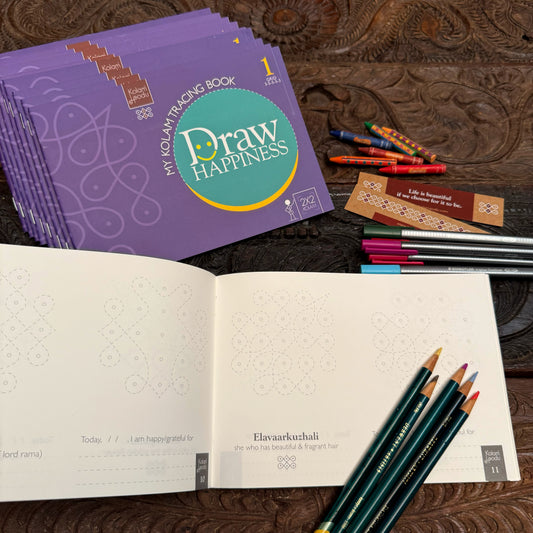Discover how the simple act of drawing a Kolam can usher in a profound sense of calmness and inner peace. This age-old practice combines mindfulness, creativity, and cultural connection to create a tranquil start to the day. From stress reduction to enhanced focus and emotional regulation, Kolam-making offers a pathway to serenity in the midst of life's chaos. Explore the philosophy of Kolam and the art of finding tranquility through this beautiful tradition. Choose the beauty of a calm life, one Kolam at a time.
The process of creating a simple kolam combines elements of mindfulness, meditation, creativity, and cultural connection, all of which contribute to promoting a state of calmness. It offers a meaningful and peaceful way to start the day, allowing individuals to find solace and tranquility amidst the busyness of life.
How does drawing of a kolam help one experience state of calm?
1. Stress Reduction: Drawing kolam brings one to a calm state, promotes relaxation and reduces stress. Engaging in a creative and meditative activity like kolam-making can help lower cortisol levels (a stress hormone) and activate the body's relaxation response, leading to a sense of calmness and inner peace.
2. Mindfulness and Present-Moment Awareness: Creating kolams requires focused attention and concentration on the present moment. By immersing ourselves in the process of drawing intricate patterns, we cultivate mindfulness, which involves being fully aware of our thoughts, emotions, and sensations in a non-judgmental way. This mindfulness practice helps shift our focus away from worries about the past or future, bringing us into the present moment and fostering a state of calm.
3. Emotional Regulation: Drawing kolam can serve as a means of emotional regulation. It allows us to channel our emotions and express ourselves creatively. When we are in a state of calmness, we are better equipped to handle and manage our emotions, reducing the likelihood of impulsive reactions or emotional outbursts. The process of creating kolams can provide a safe space for emotional release, self-reflection, and a sense of emotional balance.
4. Cognitive Clarity and Focus: When we are calm, our minds become clearer, and our ability to concentrate improves. Drawing kolams engages our cognitive faculties, such as attention, problem-solving, and spatial awareness. By being in a state of calm, we enhance our cognitive clarity and focus, allowing us to engage in the creative process more effectively and with greater enjoyment.
5. Sense of Accomplishment and Self-Esteem: Completing a kolam design can evoke a sense of accomplishment and satisfaction. When adding colours, these kolams are also referred to as rangoli kolams, “rang”, meaning colourful. It provides tangible evidence of our creative expression and the effort we put into the art form.
6. Ritualistic and Cultural Connection: The act of drawing kolams, is a part of daily rituals and cultural practices that is followed in various parts of the country. The art of the kolam is also known by many names, such as muggulu in Andhra Pradesh and Telangana, rangoli in Maharashtra, hase and rangavali in Karnataka, alopana in Bengal to name a few. Engaging in these traditions can create a sense of connection to our roots, community, and cultural heritage. This connection fosters a sense of belonging and provides a grounding effect, promoting a state of calm and contentment.
Kolam as a philosophy, combined with practicing calmness are often associated with embracing tranquility, inner peace, and emotional equanimity in one's approach to life. It stresses on the importance of remaining composed and centered amidst the chaos and challenges of everyday existence and navigate life’s ups and downs with grace and clarity. It involves embracing stillness, finding balance, and seeking harmony both within oneself and in relation to the external world.
Calmness is a subjective experience. It can vary from person to person. The impact of drawing Kolams has multiple benefits, calmness being one.
Life is beautiful if one chooses for it to be. Let's draw happiness!







